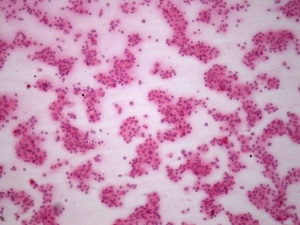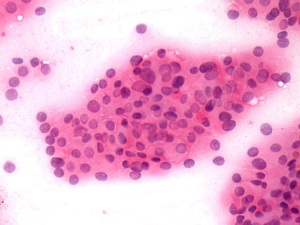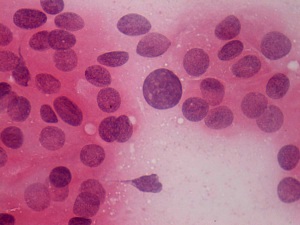Intranodular hyperechogenic figures - case 469 |
|
Clinical presentation: A 28-year-old woman was referred for evaluation of a vertigo and hair loss.
Palpation: Both lobes were moderately firm. No nodule could be palpated.
Functional state: subclinical hypothyroidism with TSH-level 7.07 mIU/L, FT4 14.0 pM/L, aTPO 496 U/mL.
Ultrasonography: The thyroid was minimally-moderately hypoechogenic. There were two more hypoechogenic lesions next to each other in the dorsal part of the right lobe. Moreover, a hypoechogenic lesion with ill-defined borders were found in the central part of the left lobe. The latter nodule presented the so-called starry sky phenomenon and intranodular vascularity.
Cytology was performed. The patient felt an unusual fear from aspiration. I told her that I plan to aspirate her three times, but she permitted me only one aspiration. As the video demonstrates, we successfully targeted the lesion in the left lobe. The cytological pattern corresponded to Hashimoto's thyroiditis. Intraoperative imprint smears are demonstrated in this case study.
Final combined clinical-ultrasound-cytological diagnosis was subclinical hypothyroidism caused by Hashimoto's thyroiditis and suspicion of papillary carcinoma with greater than 50% risk of malignancy. Considering the ultrasound presentation, we told the patient that irrespectively of the result of the cytology surgery cannot be avoided.
Surgery was performed. Intraoperative frozen section disclosed papillary carcinoma in the left lobe. Histopathology: multifocal papillary carcinoma corresponding to the lesion in the left lobe. Hashimoto's thyroiditis. No nodule was found in the right lobe.
Comments.
-
On such ultrasound presentation (starry sky phenomenon, irregular borders in a hypoechogenic nodule) the risk of a papillary carcinoma is greater than 50%.
-
This case illustrates the difficulty to gain adequate material from a vascularized tumor.
-
In the everyday practice it is not always possible to follow the recommendations, and I think that in such situations to resign from a repeat FNA was a correct decision.
-
This case illustrates the systematic need for a new way of thinking: in contrast with the current protocol, the role of ultrasound should not be only the selection of nodules for cytology but must have play a role even in the final diagnosis.











